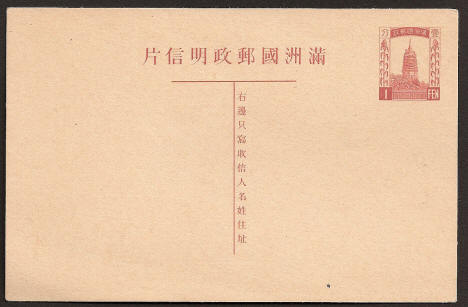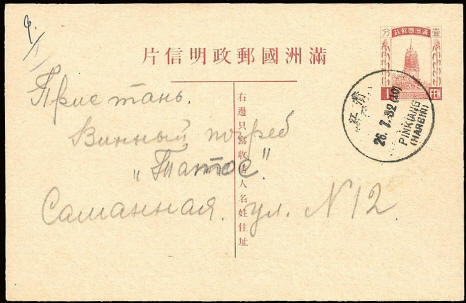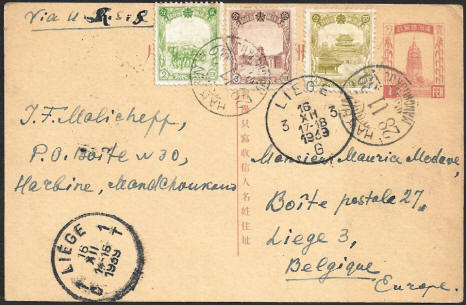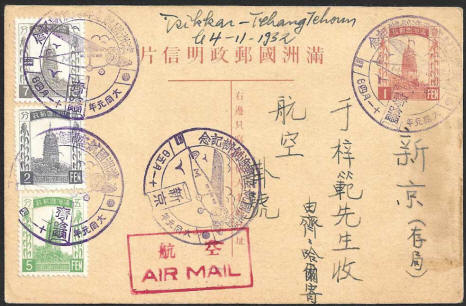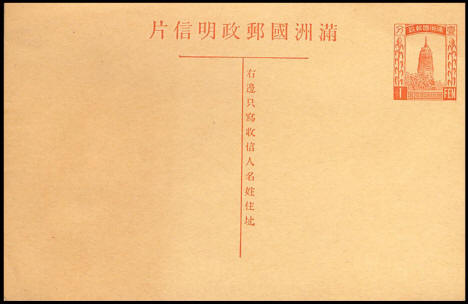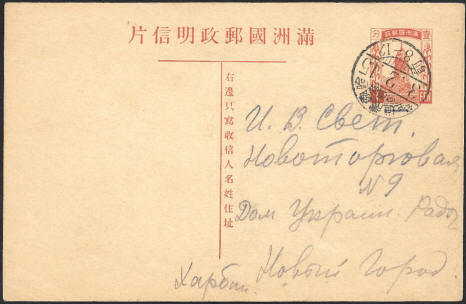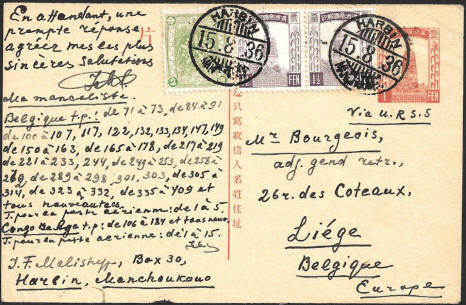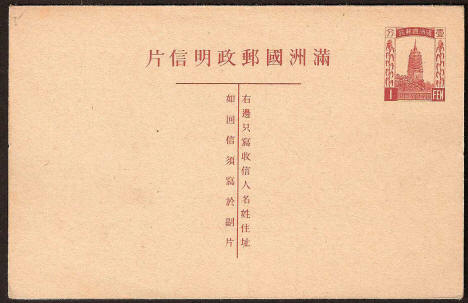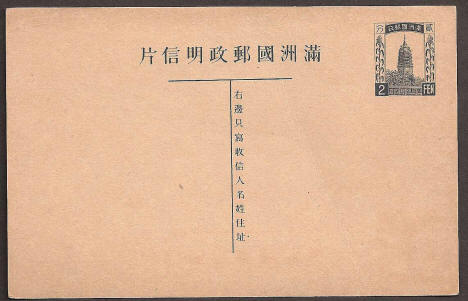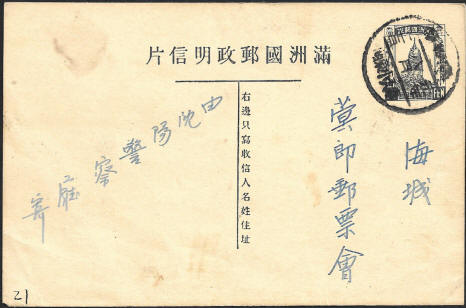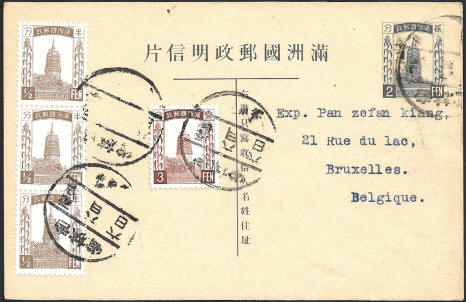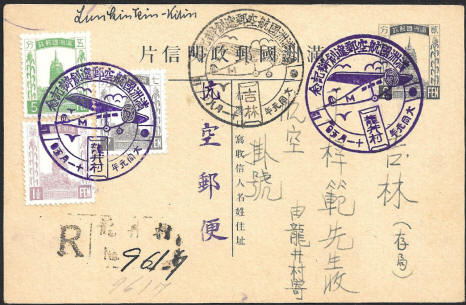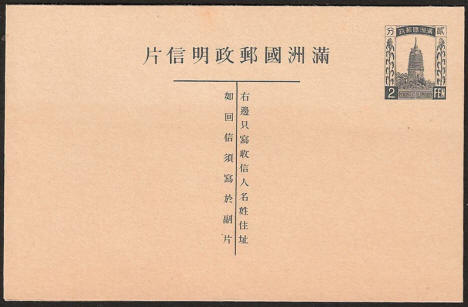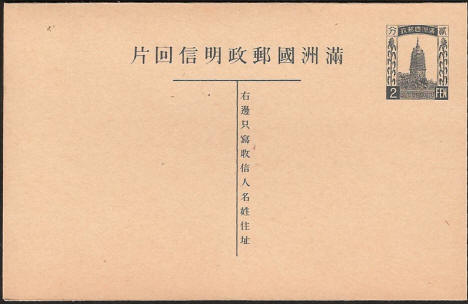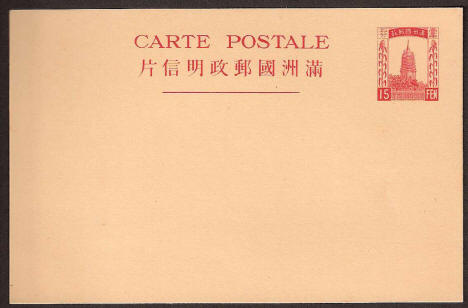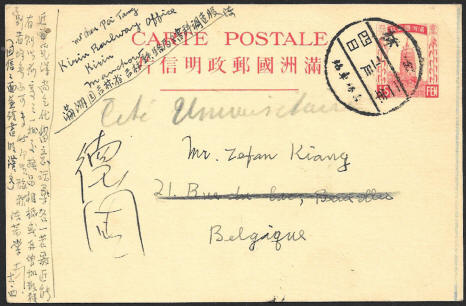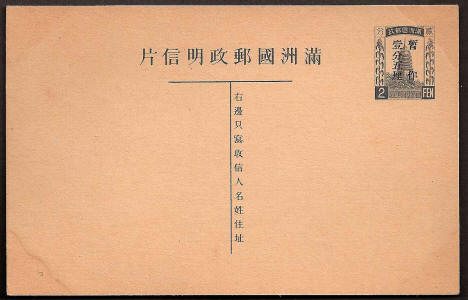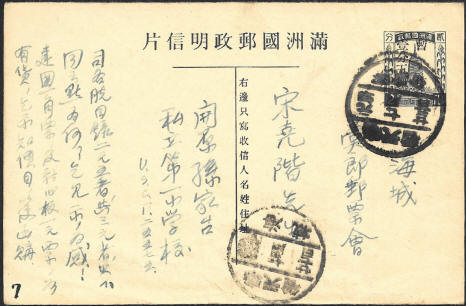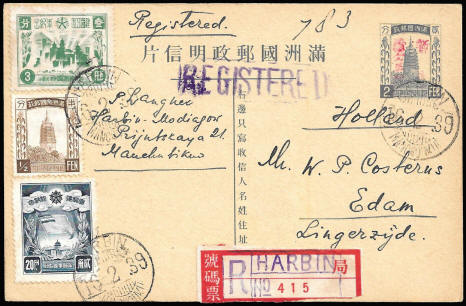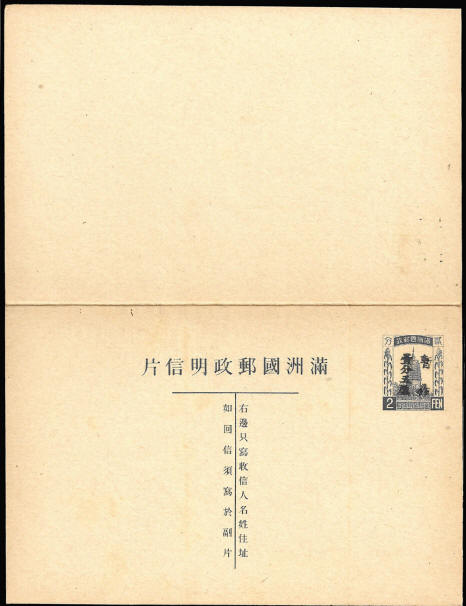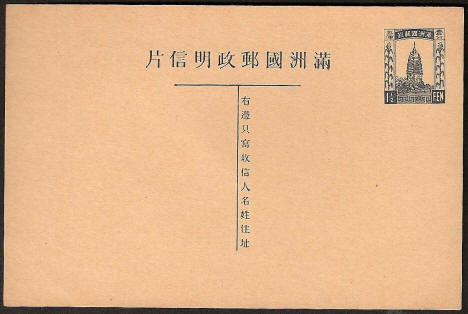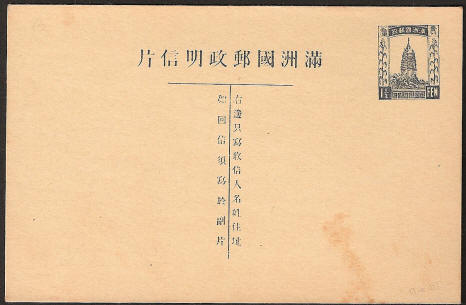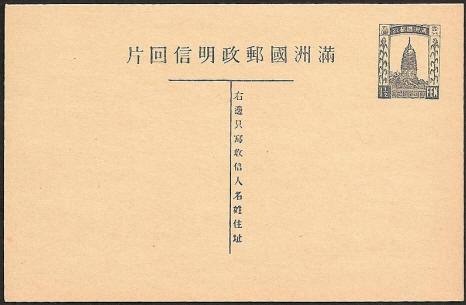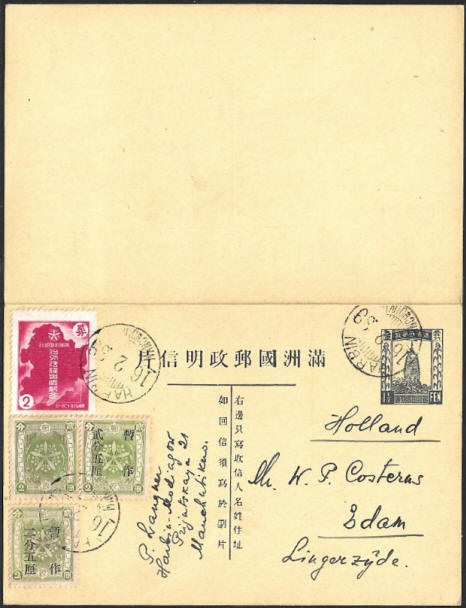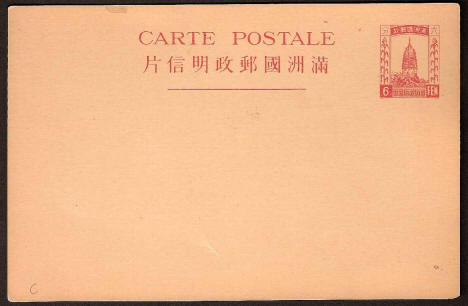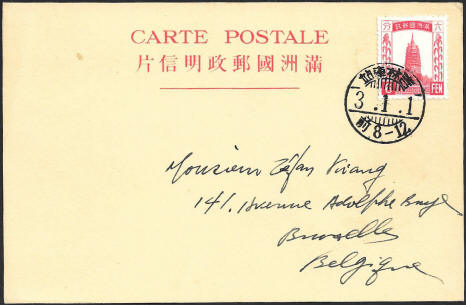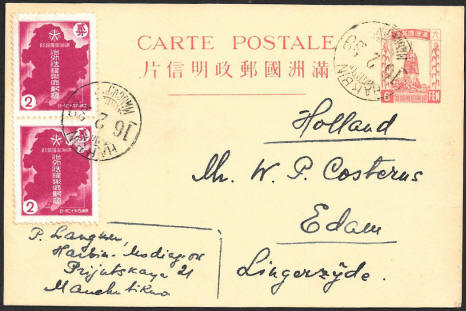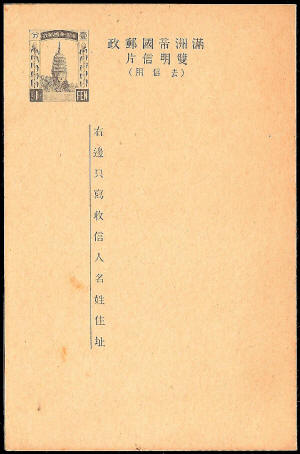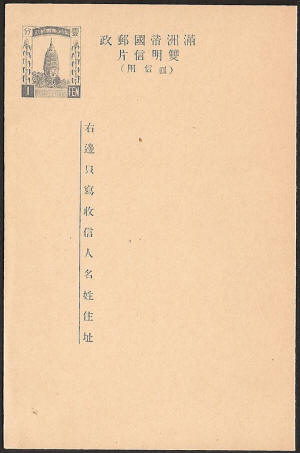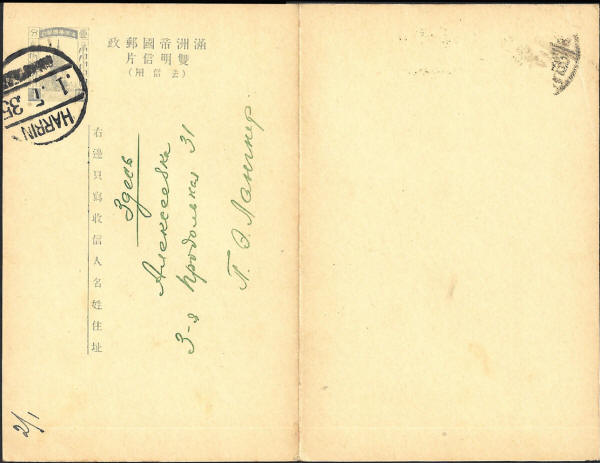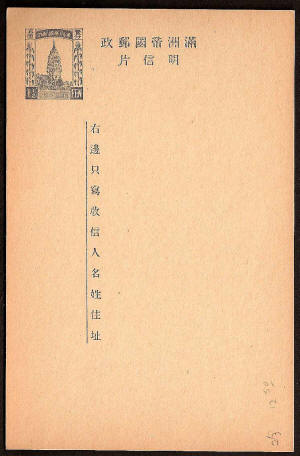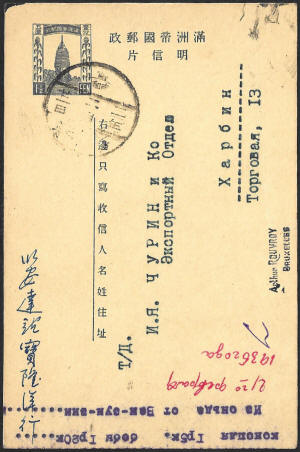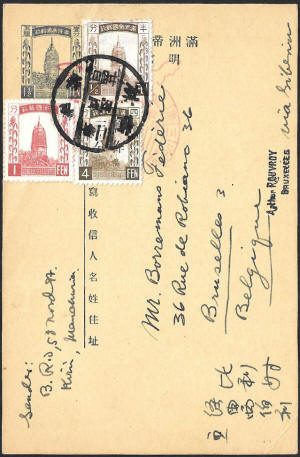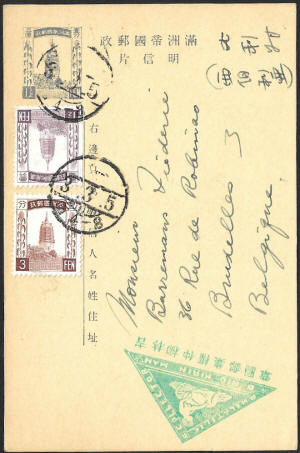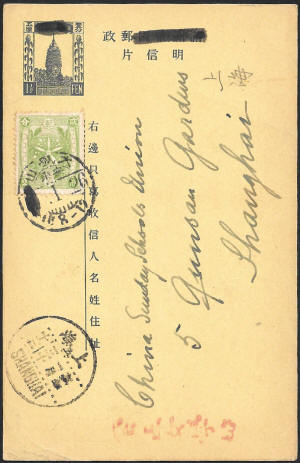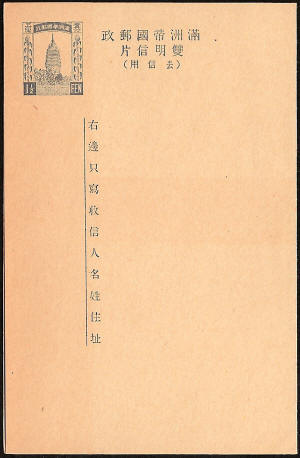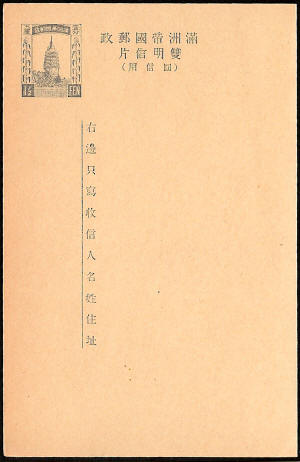 |
|||||||||||
|
Pre-Stamped Postcards Imprinted Postcards 1932 to 1934 Imprinted Postcards 1935 to 1939 Imprinted Postcards 1940 to 1950 Post Office Issued Picture Post Cards Abolition of Extraterritorial Rights
|
Official Postcards & Stationary Imprinted Postcards Issued by The Post Office of Manchukuo From 1st March 1932 Manchukuo issued a series of "imprinted" postcards, (this means prepaid cards that had the image of the necessary stamp printed directly onto the card by the Post Office). These cards fell into three main groups, domestic cards, cards for foreign mail and cards printed for use between Manchukuo and China. For part of the time, until 1937, there was also a "local" card, which meant that for 1f you could send a card within any of the main cities. The basic cards were usually 140mm x 90mm landscape in format, or 90mm x 140mm portrait. They were printed using offset lithography, on a medium weight, yellow, cream or buff coloured card. Reply paid cards, folded were the same size as normal cards and open measured 180mm x 140mm. In addition to plain imprinted cards a range of picture postcards became available, issued by Post Offices, also with imprinted stamps. Postcard prices underwent many changes over the short period of the existence of Manchukuo, whenever a change took place, cards were often up-rated (or down-rated) by the Post Office to conform to the new price, in order to use up old stock. This was done in two different ways, by the use of a surcharge (as with stamps) or by the addition of a postage stamp to bring it in line with the correct postal rate. In August 2017 I had an email from a specialist collector of commercially used postal stationary Edgard Pockelé of Belgium. Edy offered me the chance to add his Manchukuo material to this website. Virtually all of the used cards you see here form part of his collection. Used material is vital, it confirms both usage and pricing and I hope you will appreciate, as I do, his willingness to share these images. Standard Postcard Rates
|
||||||||||
| Date | Domestic & Japan | Foreign | China | Local | |||||||
| 26th July 1932 | 2 fen | 15 fen | 2 fen | 1 fen | |||||||
| 1st March 1934 |
1½ fen |
6 fen | 1½ fen | 1 fen | |||||||
| December 1934 | - | - | 2 fen | - | |||||||
| 1st April 1937 | 2 fen | 10 fen | 2 ½ fen | 1 fen | |||||||
| 1st March 1942 | 3 fen | 10 fen | 3 fen | Ended | |||||||
| 1st October 1944 | 5 fen | 10 fen | 5 fen | - | |||||||
|
|
|||||||||||
|
First Regular Issue Postcards - 26th July 1932 replaced 1935-8 The initial supply of post cards for the Manchukuo Postal Service came from Tokyo, printed by the Imperial Japanese Printing Bureau. In 1933 additional stock of the 1f and 2f standard postcards were produced at the Manchukuo Central Bank printing works at Mukden. The cards from Tokyo have the horizontal characters aligned with the centre of the imprinted stamp, whereas those printed in Mukden have the horizontal characters level with the top of the imprinted stamp. Reply paid cards and the 15f card all originate from Tokyo. All the designs are based upon the "First Regular Issue" of postage stamps. Used card dated 26. 7. 32. Harbin (Image: Edgard Pockelé of Belgium) 26th July 1932 1f Local Rate Postcard (Printed in Tokyo) - The Post Office operated a Local service within a city for postcards costing 1 fen and these were pre-printed with this rate. If being sent outside of the city an additional 1 fen stamp was needed. To see a nice example of a local postcard in commercial use click here. The eight characters at the top of the card, written horizontally, read (right to left) - "Manchu State Postal Service Postal Card". The vertical line of 11 characters reads "Write the name and address on the right hand side". The cards could be on buff or cream card - see above. This is an example of a Japanese printed 1f local postcard up-rated to 10f and sent to Belgium. Note the date shown on the international cancel 28the November 1939, this represents very late usage as these cards were replaced on 1st April 1937 with a design featuring the State Council Building. The1f local postage rate continued until November 1940. This is a a domestic airmail example of a 1f Japanese printed postcard sent registered from Tsitsihar to the capital Hsinking. Cancels show the card left Tsitsihar on 4th October 1932 and arrived in Hsinking the following day, the aircraft would have made a mail and refuelling stop at Harbin where it spent the night. The postage is correct 9f for airmail + 6f for registration (there is part of a registration form attached to the back of the card). Used card dated 3. 2. 34. Harbin 26th July 1932 1f Local Rate Postcard (Printed in Mukden) - Above are used and unused examples of the Mukden printing, note that the eight large characters line up with the top of the imprinted stamp and because of this the centre dividing line is longer. Both examples are on identical cream card. This shows that it did not take Manchukuo long to set up and manufacture postcards to be by the postal, service but in spite of this cards made in Japan are far more common. This is an example of a Mukden printed 1f local postcard up-rated to 6f and sent to Belgium. Note the date shown on the international cancel 15th August 1936. These cards were replaced on 1st April 1937 with a design featuring the State Council Building but the 1f local postage rate continued until November 1940. 26th July 1932 1f + 1f Reply Paid Postcard, above are both parts of this card, the top copy is for use by the sender and below the reply section used by the recipient. (Printed in Tokyo). The characters used on the top copy this card are similar to the above, but with the additional 8 vertical characters which read "Attached card is for reply". The bottom copy has an extra character in the horizontal heading "Manchu State Postal Service Reply Paid Postal Card". 26th July 1932 2f Postcard (Printed in Tokyo) for domestic use and for mail to Japan and China (China would also charge the recipient 4c postage due because they did not recognise the Manchukuo Post Office and considered its stamps invalid). Note that this example is on buff card, cream was also used see the used card shown below. This is a used example of the 2f domestic rate postcard printed in Japan on cream card. The cancel is dated 2nd August 1934 and this means that the postage was overpaid by ½f as the rate for domestic postcards dropped to 1½f on 1st March 1934. This used example on cream card has been up-rated for international use to Belgium. It was sent on Kirin on 6th June 1934 and at this time the the international rate was 6f so the sender has overpaid on postage by ½f. . This card has been sent by airmail from 龍井(村) Lung-ching-ts'un (ts,un means village) to 吉林 Kirin. The card started it's journey on 5th October 1932 and arrived at Kirin on the 8th October 1932. Although the aircraft probably made a refuelling stop at 通化 T’ung-hua, I think three days travel time shows the flight may have been delayed due to bad weather or a breakdown. The correct postage would have been 9f for airmail + 6f for registration this card has therefore been overpaid by ½f. 26th July 1932 2f + 2f Reply Paid Postcard (Printed in Tokyo) for domestic use and for mail to Japan and China. 26th July 1932 15f Postcard (Printed in Tokyo) for foreign destinations hence the "Carte Postale". The characters read (from right to left) Manchukuo Post Office Postal Card. It is interesting to note that the imprinted stamp on this card shows the White Pagoda and not Puyi, as appears the postage stamp of the same value. This is an example of a used 15f International use postcard sent to Belgium. The cancel confirms that the card was sent from Kirin on 4th November 1933. . |
|||||||||||
|
Price Changes 1st March 1934 On 1st March 1934 postal prices were reduced but only overprinted versions of the 2f card (both Tokyo and Mukden printings) were available for purchase on this date. The overprint consists of 6 characters, the characters on the left being the denomination 1½f; the two characters on the right meaning "temporary use". The reply paid version of this card also had an overprint applied. These overprints exist in many variations (see below) and the overprinting work was done in the major cities of Hsinking, Mukden and Harbin. Hard black overprints appear to have been made typographically and the softer black overprints may be the result of a rubber stamp. A soft red hand-stamped overprint is known to exist on cards printed in Mukden only - see below. (I have assigned types "a" to "f" to the examples below on a purely arbitrary basis). 1st March 1934 1½f Surcharge on 2f 1932 postcard (Card printed in Tokyo). Type a. Hard black surcharge - height of surcharge 14.1mm (Card printed in Mukden). Type b. Hard black surcharge - height of surcharge 12.3mm (Card printed in Tokyo). Type c. Hard black surcharge - height of surcharge 12.5mm, top right character missing (Card printed in Mukden). This card was sent from Mukden to Hsinking. Type d. Soft black surcharge - height of surcharge 14mm (Card printed in Mukden). Type e. Watery black surcharge - height of surcharge 12.8mm approx (Card printed in Mukden). Type f. Hard black surcharge - height of surcharge 13.2mm approx (Card printed in Mukden). Type g. Red surcharge - height of surcharge 12.7mm approx (Card printed in Mukden). This is an example of domestically used (type b). postcard see above. The native postmark shows that it was sent from 海城 Haicheng on 27th July 1934. This 1½f card is the correct for this date. . This is a nice used example of a red surcharged domestic postcard up-rated for international use. The card travelled from Harbin on 16th February 1939 to Holland. The fact that the Harbin registration label was not changed at Mukden indicates that the card went by the Siberian route. The postage is underpaid by 1f but this seems to have been allowed, the international postcard rate was 10f at this time and registration an extra 16f. 2f + 2f Reply Card overprinted 1½f + 1½f this is a soft black surcharge on a card printed in Tokyo. March/April 1934 1½f Postcard for domestic use and for mail to Japan. There is also a reply paid version of this card - see below. March/April 1934 1½f + 1½f Reply Paid Postcard for domestic use and for mail to Japan. Note that the reply card is almost identical to the normal 1½f postcard. The difference is the length of the vertical dividing line which continues well below the last character. This is an example of a 1½f reply card up-rated by the application of 9f in value of postage stamps for international use to Holland. The reply section remains unused. The postage at this time, February 1939 was 10f each way so the outgoing card was overpaid by ½f . It seems doubtful that it would have been possible to use the reply section from any overseas destination other than Japan as Manchukuo was unable to join the U.P.U. . March/April 1934 6f Postcard for all overseas destinations, excluding Japan and China. There is also a reply paid version of this card. 1st January 1934. This is a 15f postcard with the indicia covered by 6f stamp. A possible explanation for this may be that post offices re-valued stocks of old 15f cards to overcome shortages of stock of the new 6f cards. This example was sent from 吉林車站 Kirin Station to Belgium on 1st January 1934. The international postcard rate changed from 6f to 10f on 1st April 1937 after this any remaining cards needed to be up-rated to be delivered. This card was not sent from Harbin until 16th February 1939 and so it needed to carry extra stamps to the value of 4f.
New Format 1st November 1934 The main reason for the issue of these new cards was the renaming of the state "Manchu Empire", this results in the change of heading seen below, now reading "Manchu Empire Postal Service Post Card". The vertical line of 11 characters continues to read "Write the name and address on the right hand side" as before. The Post Office changed the format of all domestic postcards from the Chinese style landscape format to portrait. These were better suited to Japanese calligraphy (by this time Japanese was the language being taught in schools). Postcards to foreign destinations, excluding Japan, would remain in landscape format. Three cards were issued at this time, a 1f x 1f reply paid postcard, a 1½f postcard and a 1½f x 1½f reply paid postcard. Both a 1f postcard and a 6f postcard were to be included in this format but for some reason these were never issued. A note on a card in my collection states that these cards were produced by the Ukrainian Publishing Company, Harbin. Further research would be needed to confirm this. 1st November 1934 1f + 1f Reply Paid Card (front and back shown above). These were printed on cream card (listed) and buff (unlisted) and the card illustrated is an example of a minor variety reported by Spalding. The last character shown above is out of alignment with the other two (second picture) having been displaced downwards, this card is also buff, a colour not reported by Spalding, while Higgins and Gage list cream to yellow buff, so it may be that the buff card used turns yellowish on exposure to light. This seems to have been the case with the card shown above. This is a copy of a 1f x 1f reply card used within the city of Harbin on 1st May 1935 (the reply section remains unused). You may be wondering about the lack of a town name. In Russian you can see underlined ЗДeСЬ, this simply means "here" so as the card had been posted in Harbin the post office needed no further information. The price of 1f for a local postcard did not change from 1st March 1932 until 16th November 1940 when the service was abolished. . 1st November 1934 1½f postcard, note that as with the 3rd regular issue stamps the imprinted stamp now has six characters in the heading at the top. 1½f postcard used domestically. Posted on 21st February 1935 to Harbin. . Both of the above cards were sent to Belgium by the stamp collector and part time dealer B. Rio of Kirin. On close inspection of the first item you will notice that the card had already been cancelled and so ignoring the indicia only 5½f of postage has been paid. The second item shows postage totalling 6f, the correct amount. . This is a 1½f postcard sent to Shanghai in China from 大孤山 Ta-Ku-Shan in Antung Province on 26th January 1937. The card arrived on 30th January 1937, a transit time of 4 days. A Chinese postal worker went to some trouble to obliterate all references to Manchukuo, including the year date shown on the cancel. At this time the postcard rate to China was 2f so the sender need not have used a pre-paid card. . 1st November 1934 1½f + 1½f Reply Paid Postcard
Sources of the information used in this page - The first person to write definitively (in English) about the Imprinted Postcards of Manchukuo was Dr. Robert M. Spaulding Jr., his "The Catalogue of Postal Stationary of the Japanese Occupation of China, Part One, Manchuria", forms the core of Western knowledge of this subject and was the basis of the Higgins & Gage section on Manchukuo. I have found both works very helpful in compiling this page. Other references include the JSCA Japanese Stamp Specialized Catalogue Vol. 3 and articles from "The China Clipper", the journal of the China Stamp Society. |
|||||||||||
